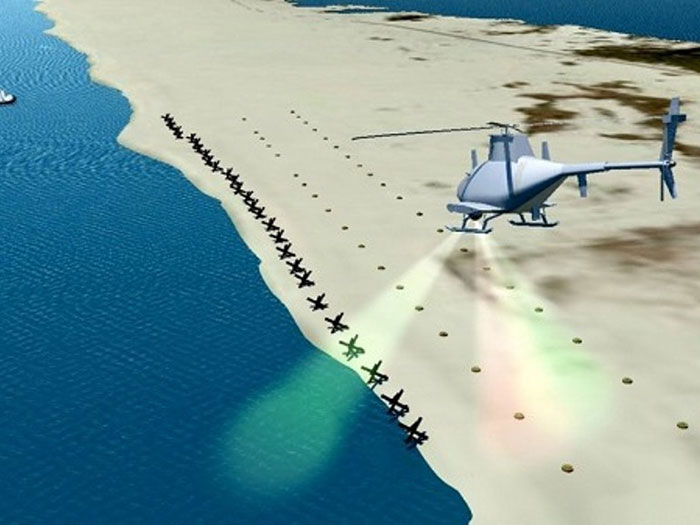US Navy Awards 2 Contracts to Boeing, BAE Systems
10.04.2013 North America
A new precision-guided weapon that Boeing will provide to the U.S. Navy will fundamentally change anti-submarine warfare by incorporating technologies never before used on an anti-submarine weapon.
Through a recently awarded $19.2 million contract, Boeing will design and build the High Altitude Anti-Submarine Warfare Weapon Capability (HAAWC).
The system will leverage combat-proven technologies from Boeing’s Joint Direct Attack Munition (JDAM) and Small Diameter Bomb (SDB) so it can be launched from high altitudes and far from targets.
“A new era in anti-submarine warfare is about to begin. The capability HAAWC gives U.S. Navy sub-hunters is unparalleled compared with what is available today,” said James Dodd, Vice President of Boeing Weapons & Missile Systems.
Adapting current JDAM and SDB technologies will also reduce development risk and cost for the Navy.
“Providing this advanced capability to Navy warfighters as soon as possible is vital to help protect the United States’ maritime interests around the world,” said Scott Wuesthoff, Director of Boeing Direct Attack Weapons.
Meanwhile, BAE Systems has been awarded a $20 million contract to develop an advanced prototype system that detects mines and obstacles in near-shore waters for the U.S. Navy and Marine Corps. As part of the Coastal Battlefield Reconnaissance and Analysis (COBRA) program, the laser-based airborne system will provide 24-hour capability to ensure our troops’ safe transition from ship to shore.
“This program will help save lives, and to us there is no better reward than providing technology to help protect those who put themselves in harm’s way while serving our nation,” said Reid Noguchi, General Manager of BAE Systems Spectral Solutions.
“Having conducted extensive research and development in advanced sensors, airborne prototype systems, and sophisticated real time software, BAE Systems has worked closely with the Office of Naval Research (ONR) to mature the technologies and capabilities to meet the Navy’s mine countermeasures needs on an accelerated timeline,” Noguchi added.
These technologies are being prototyped under Section 819 of the National Defense Authorization Act, which is aimed at the development of advanced components or prototypes, according to Brian Almquist, program officer in the ONR Ocean Battlespace Sensing Department. “This law helps to reduce acquisition costs and also accelerates delivery of technology to the fleet to protect our sailors and marines from this prolific threat,” Almquist said.
The COBRA program leverages BAE Systems’ borderless approach to harness key resources in design, integration, and testing. The work will be performed at the company’s facilities in Honolulu, Hawaii; Greenlawn, New York; Acton, Massachusetts; and Hudson, New Hampshire.
Through a recently awarded $19.2 million contract, Boeing will design and build the High Altitude Anti-Submarine Warfare Weapon Capability (HAAWC).
The system will leverage combat-proven technologies from Boeing’s Joint Direct Attack Munition (JDAM) and Small Diameter Bomb (SDB) so it can be launched from high altitudes and far from targets.
“A new era in anti-submarine warfare is about to begin. The capability HAAWC gives U.S. Navy sub-hunters is unparalleled compared with what is available today,” said James Dodd, Vice President of Boeing Weapons & Missile Systems.
Adapting current JDAM and SDB technologies will also reduce development risk and cost for the Navy.
“Providing this advanced capability to Navy warfighters as soon as possible is vital to help protect the United States’ maritime interests around the world,” said Scott Wuesthoff, Director of Boeing Direct Attack Weapons.
Meanwhile, BAE Systems has been awarded a $20 million contract to develop an advanced prototype system that detects mines and obstacles in near-shore waters for the U.S. Navy and Marine Corps. As part of the Coastal Battlefield Reconnaissance and Analysis (COBRA) program, the laser-based airborne system will provide 24-hour capability to ensure our troops’ safe transition from ship to shore.
“This program will help save lives, and to us there is no better reward than providing technology to help protect those who put themselves in harm’s way while serving our nation,” said Reid Noguchi, General Manager of BAE Systems Spectral Solutions.
“Having conducted extensive research and development in advanced sensors, airborne prototype systems, and sophisticated real time software, BAE Systems has worked closely with the Office of Naval Research (ONR) to mature the technologies and capabilities to meet the Navy’s mine countermeasures needs on an accelerated timeline,” Noguchi added.
These technologies are being prototyped under Section 819 of the National Defense Authorization Act, which is aimed at the development of advanced components or prototypes, according to Brian Almquist, program officer in the ONR Ocean Battlespace Sensing Department. “This law helps to reduce acquisition costs and also accelerates delivery of technology to the fleet to protect our sailors and marines from this prolific threat,” Almquist said.
The COBRA program leverages BAE Systems’ borderless approach to harness key resources in design, integration, and testing. The work will be performed at the company’s facilities in Honolulu, Hawaii; Greenlawn, New York; Acton, Massachusetts; and Hudson, New Hampshire.
Previous PostF-35B Completes First Night Time Vertical Landing
Latest news
Latest events
Counter UAS Middle East & Africa 2025
16 - 17 Sep 2025Amman - JordanIntersec Saudi Arabia
29 Sep - 01 Oct 2025Riyadh International Exhibition & Convention Centre - Saudi ArabiaDubai International Air Chiefs’ Conference (DIACC 2025)
16 Nov 2025Atlantis, The Palm Dubai - United Arab EmiratesDubai Airshow
17 - 21 Nov 2025Dubai World Central (DWC) - United Arab Emirates





















